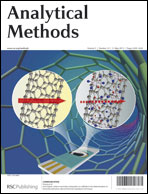In this study, we report new results concerning the analytical performance of a novel portable vacuum compatible device enabling in situ study of aqueous surfaces using vacuum-based surface analysis tools. The surfaces of aqueous solutions of three representative organic molecules (formic acid, glycerol, and glutamic acid) were analyzed using time-of-flight secondary ion mass spectrometry (ToF-SIMS). Their molecular signals were successfully observed. The device can be operated without interruption in vacuum for up to 8 hours, and SIMS measurements are feasible at any time in this time range. The stability testing of our device under primary ion beam bombardment shows that high fluence (6 × 1012 ions per cm2 s−1) measurements can be operated continuously for up to 30 minutes without any significant damage to the aperture. However, extra-high fluence measurements (>1 × 1014 ions per cm2 s−1) may lead to rapid boiling in the aperture, and the aqueous solutions may spread out quickly. Device reproducibility is studied for both consecutive measurements over a short period of time (e.g., 5 min) and intermittent measurements over a long time (e.g., several hours). The relative standard deviation (RSD) for molecular ion signals was determined to be less than 15% for consecutive measurements in 5 min. As to total counts, the RSD is determined to be less than 1% for each chemical compound. Higher RSDs of ±40–50% were obtained for intermittent measurements in a few hours, both acceptable for semi-quantitative analysis. In addition, the detection limits of formic acid, glycerol, and glutamic acid are estimated to be 0.04%, 0.008%, and 0.002% (weight ratio), respectively.


 Please wait while we load your content...
Please wait while we load your content...